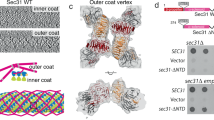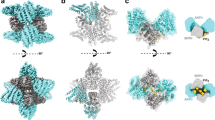Abstract
Coat proteins allow the selective transfer of macromolecules from one membrane-enclosed compartment to another by concentrating macromolecules into specialized membrane patches and then deforming these patches into small coated vesicles. Recent findings indicate that coat proteins might also participate in the differentiation of membrane domains within organelles and large transport carriers, as well as in the association of the carriers with the cytosketelon and with acceptor organelles.
This is a preview of subscription content, access via your institution
Access options
Subscribe to this journal
Receive 12 print issues and online access
$189.00 per year
only $15.75 per issue
Buy this article
- Purchase on Springer Link
- Instant access to full article PDF
Prices may be subject to local taxes which are calculated during checkout




Similar content being viewed by others
References
Palade, G. Intracellular aspects of the process of protein secretion. Science 189, 347–358 (1975).
Roth, T. E. & Porter, K. R. Yolk protein uptake in the oocyte of the mosquito Aedes Aegypti L. J. Cell Biol. 20, 313–332 (1964).
Friend, D. S. & Farquhar, M. G. Functions of coated vesicles during protein absorption in the rat vas deferens. J. Cell Biol. 35, 357–376 (1967).
Kanaseki, T. & Kadota, K. The 'vesicle in a basket'. A morphological study of the coated vesicle isolated from the nerve endings of guinea pig brain, with special reference to the mechanism of membrane movement. J. Cell Biol. 42, 202–220 (1969).
Pearse, B. M. Coated vesicles from pig brain: purification and biochemical characterization. J. Mol. Biol. 97, 93–98 (1975).
Kirchhausen, T. Clathrin. Annu. Rev. Biochem. 69, 699–727 (2000).
Kirchhausen, T. Adaptors for clathrin-mediated traffic. Annu. Rev. Cell Dev. Biol. 15, 705–732 (1999).
Robinson, M. Adaptins. Trends Cell Biol. 2, 293–297 (1992).
Heilker, R., Spiess, M. & Crottet, P. Recognition of sorting signals by clathrin adaptors. Bioessays 21, 558–567 (1999).
Slepnev, V. I. & De Camilli, P. Accessory factors in clathrin-dependent synaptic vesicle endocytosis. Nature Rev. Neurosci. 1, 161–172 (2000).
Boman, A. L. GGA proteins: new players in the sorting game. J. Cell Sci. 114, 3413–3418 (2001).
Polo, S. et al. A single motif responsible for ubiquitin recognition and monoubiquitination in endocytic proteins. Nature 416, 451–455 (2002).
Raiborg, C. et al. Hrs sorts ubiquitinated proteins into clathrin-coated microdomains of early endosomes. Nature Cell Biol. 4, 394–398 (2002).
Rothman, J. E. & Wieland, F. T. Protein sorting by transport vesicles. Science 272, 227–234 (1996).
Schekman, R. & Orci, L. Coat proteins and vesicle budding. Science 271, 1526–1533 (1996).
Kirchhausen, T. Three ways to make a vesicle. Nature Rev. Mol. Cell Biol. 1, 187–198 (2000).
Donaldson, J. G. & Jackson, C. L. Regulators and effectors of the ARF GTPases. Curr. Opin. Cell Biol. 12, 475–482 (2000).
Ford, M. G. et al. Curvature of clathrin-coated pits driven by epsin. Nature 419, 361–366 (2002).
Waters, M. G., Serafini, T. & Rothman, J. E. 'Coatomer': a cytosolic protein complex containing subunits of non-clathrin-coated Golgi transport vesicles. Nature 349, 248–251 (1991).
Barlowe, C. et al. COPII: a membrane coat formed by Sec proteins that drive vesicle budding from the endoplasmic reticulum. Cell 77, 895–907 (1994).
Dell'Angelica, E. C. et al. AP-3: an adaptor-like protein complex with ubiquitous expression. EMBO J. 15, 917–928 (1997).
Simpson, F., Peden, A. A., Christopoulou, L. & Robinson, M. S. Characterization of the adaptor-related protein complex, AP-3. J. Cell Biol. 137, 835–845 (1997).
Dell'Angelica, E. C., Mullins, C. & Bonifacino, J. S. AP-4, a novel protein complex related to clathrin adaptors. J. Biol. Chem. 274, 7278–7285 (1999).
Hirst, J., Bright, N. A., Rous, B. & Robinson, M. S. Characterization of a fourth adaptor-related protein complex. Mol. Biol. Cell 10, 2787–2802 (1999).
Dell'Angelica, E. C., Klumperman, J., Stoorvogel, W. & Bonifacino, J. S. Association of the AP-3 adaptor complex with clathrin. Science 280, 431–434 (1998).
Peden, A. A., Rudge, R. E., Lui, W. W. & Robinson, M. S. Assembly and function of AP-3 complexes in cells expressing mutant subunits. J. Cell Biol. 156, 327–336 (2002).
Boehm, M. & Bonifacino, J. S. Adaptins: the final recount. Mol. Biol. Cell 12, 2907–2920 (2001).
Antonny, B. & Schekman, R. ER export: public transportation by the COPII coach. Curr. Opin. Cell Biol. 13, 438–443 (2001).
Bi, X., Corpina, R. A. & Goldberg, J. Structure of the Sec23/24-Sar1 pre-budding complex of the COPII vesicle coat. Nature 419, 271–277 (2002).
Orci, L., Glick, B. S. & Rothman, J. E. A new type of coated vesicular carrier that appears not to contain clathrin: its possible role in protein transport through the Golgi stack. Cell 46, 171–184 (1986).
Bednarek, S. Y. et al. COPI- and COPII-coated vesicles bud directly from the endoplasmic reticulum in yeast. Cell 83, 1183–1196 (1995).
Malhotra, V., Serafini, T., Orci, L., Shepherd, J. C. & Rothman, J. E. Purification of a novel class of coated vesicles mediating biosynthetic protein transport through the Golgi stack. Cell 58, 329–336 (1989).
Presley, J. F. et al. Dissection of COPI and Arf1 dynamics in vivo and role in Golgi membrane transport. Nature 417, 187–193 (2002).
Hirschberg, K. et al. Kinetic analysis of secretory protein traffic and characterization of Golgi to plasma membrane transport intermediates in living cells. J. Cell Biol. 143, 1485–1503 (1998).
Huang, F., Nesterov, A., Carter, R. E. & Sorkin, A. Trafficking of yellow-fluorescent-protein-tagged μ1 subunit of clathrin adaptor AP-1 complex in living cells. Traffic 2, 345–357 (2001).
Waguri, S. et al. Visualization of TGN to endosomes trafficking through fluorescently labeled MPR and AP-1 in living cells. Mol. Biol. Cell 14, 142–155 (2002).
Puertollano, R. et al. Morphology and dynamics of clathrin/GGA1-coated carriers budding from the trans-Golgi network. Mol. Biol. Cell (in the press).
Kaether, C., Skehel, P. & Dotti, C. G. Axonal membrane proteins are transported in distinct carriers: a two-color video microscopy study in cultured hippocampal neurons. Mol. Biol. Cell 11, 1213–1224 (2000).
Ahmari, S. E., Buchanan, J. & Smith, S. J. Assembly of presynaptic active zones from cytoplasmic transport packets. Nature Neurosci. 3, 445–451 (2000).
Aridor, M., Bannykh, S. I., Rowe, T. & Balch, W. E. Sequential coupling between COPII and COPI vesicle coats in endoplasmic reticulum to Golgi transport. J. Cell Biol. 131, 875–893 (1995).
Gaidarov, I., Santini, F., Warren, R. A. & Keen, J. H. Spatial control of coated-pit dynamics in living cells. Nature Cell Biol. 1, 1–7 (1999).
Nakagawa, T. et al. A novel motor, KIF13A, transports mannose-6-phosphate receptor to plasma membrane through direct interaction with AP-1 complex. Cell 103, 569–581 (2000).
Shiba, Y., Takatsu, H., Shin, H. W. & Nakayama, K. γ-adaptin interacts directly with rabaptin-5 through its ear domain. J. Biochem. (Tokyo) 131, 327–336 (2002).
Volchuk, A. et al. Megavesicles implicated in the rapid transport of intracisternal aggregates across the Golgi stack. Cell 102, 335–348 (2000).
Heuser, J. & Kirchhausen, T. Deep-etch views of clathrin assemblies. J. Ultrastruct. Res. 92, 1–27 (1985).
Raposo, G., Tenza, D., Murphy, D. M., Berson, J. F. & Marks, M. S. Distinct protein sorting and localization to premelanosomes, melanosomes, and lysosomes in pigmented melanocytic cells. J. Cell Biol. 152, 809–824 (2001).
Sachse, M., Urbe, S., Oorschot, V., Strous, G. J. & Klumperman, J. Bilayered clathrin coats on endosomal vacuoles are involved in protein sorting toward lysosomes. Mol. Biol. Cell 13, 1313–1328 (2002).
Wu, X. et al. Clathrin exchange during clathrin-mediated endocytosis. J. Cell Biol. 155, 291–300 (2001).
Wu, X. et al. Adaptor and clathrin exchange at the plasma membrane and trans-Golgi network. Mol. Biol. Cell 14, 516–528 (2003).
Goldberg, J. Decoding of sorting signals by coatomer through a GTPase switch in the COPI coat complex. Cell 100, 671–679 (2000).
Collins, B. M., McCoy, A. J., Kent, H. M., Evans, P. R. & Owen, D. J. Molecular architecture and functional model of the endocytic AP2 complex. Cell 109, 523–535 (2002).
Lederkremer, G. Z. et al. Structure of the Sec23p/24p and Sec13p/31p complexes of COPII. Proc. Natl Acad. Sci. USA 98, 10704–10709 (2001).
Acknowledgements
We thank S. Caplan and M. Boehm for critically reviewing the manuscript.
Author information
Authors and Affiliations
Corresponding author
Related links
Related links
DATABASES
InterPro
LocusLink
Swiss-Prot
FURTHER INFORMATION
Rights and permissions
About this article
Cite this article
Bonifacino, J., Lippincott-Schwartz, J. Coat proteins: shaping membrane transport. Nat Rev Mol Cell Biol 4, 409–414 (2003). https://doi.org/10.1038/nrm1099
Issue Date:
DOI: https://doi.org/10.1038/nrm1099
This article is cited by
-
Generation of nanoscopic membrane curvature for membrane trafficking
Nature Reviews Molecular Cell Biology (2023)
-
An Update on the Critical Role of α-Synuclein in Parkinson’s Disease and Other Synucleinopathies: from Tissue to Cellular and Molecular Levels
Molecular Neurobiology (2022)
-
Conventional Molecular and Novel Structural Mechanistic Insights into Orderly Organelle Interactions
Chemical Research in Chinese Universities (2021)
-
Vesicular transport mediates the uptake of cytoplasmic proteins into mitochondria in Drosophila melanogaster
Nature Communications (2020)
-
Detection of the in vitro modulation of Plasmodium falciparum Arf1 by Sec7 and ArfGAP domains using a colorimetric plate-based assay
Scientific Reports (2020)



